|
There’s a Polish proverb that says “Lepsze rydz niż nic.” In literal translation it says “Better the Lactarius deliciousus (saffron milkcap mushroom) than nothing at all.” On another level it’s said in situations to indicate that something was gained but not exactly what you wanted or what you got was better than nothing at all. In the mushroom picking world of Poland everyone would prefer to find Boletus edulis, the porcini mushroom, king of forest mushrooms. However, in the absence of porcini, the saffron milk cap will do. There’s a reason this woman, who just emerged from the forest, is happy to pose for me. She holds in her hand a lovely specimen of the much sought-after Boletus edulis called prawdziwek (translates into “the true one” in Polish) and also called borowik szlachetny or “noble boletus.” It is considered the tastiest of all edible mushrooms whether dried or marinated and was the preferred mushroom for the tables of Poland’s rich and famous. Jan Kochanowski (1530-1584), a famous 16th century poet and author, described the duties of workers on his estate. There were those tending the grain harvests, the vegetable gardens, the dairy barns and then there were those assigned to gather mushrooms. Foraging for mushrooms was not a hobby like it is now but genuinely hard work as it was an important foodstuff from May until first frosts. Mushrooms were eaten fresh, dried for use in the wintertime, and when salt became widely available, they were stored by salting down or pickling. 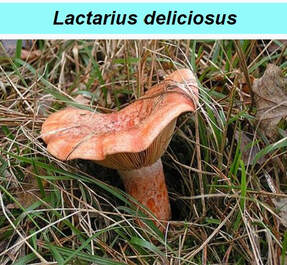 So what about the second rate saffron milkcap? the Lactarius deliciosus? Why give it such a name if not delicious? As the proverb implies, it’s a consolation prize, something one could enjoy even if not fully what you wanted. Lucyna Ćwierczakiewicz (1826-1901), the famous Polish cookbook author, wrote a lot about mushrooms and didn’t scorn it at all. "Mushrooms are collected twice a year in spring and autumn. The young tender spring mushrooms should be sliced and dried in the sun and will be like fresh when added to vegetables in winter. The fall mushrooms should be dried on a string or in the oven after baking bread or for marinating because they are longer lasting and easier to keep. Rydze begin at the end of August until late into the year. Be careful to get them as frosts can begin early in November and the rydze are lost. “ Besides drying, salting and pickling mushrooms for winter consumption, mushrooms were also collected to trade or to sell at the marketplace to buy items like kerosene, matches or shoes. Market in Krakow 1931. Images from Narodowe Archiwum Cyfrowe. I grew up listening to my mother talk about the forests of Poland where she picked berries and mushrooms with her siblings. She used the proverb Lepsze rydz niż nic a lot. It’s her I think about when on mushroom hunting excursions with my cousins in Poland. In the third photo, my basket is the empty one behind the bouquet of heather I had picked. There were only two mushrooms left in my basket by the time my cousin finished throwing out all the non-edible ones I had picked. Embarrassing, since even little Tomek knew his mushrooms but as the proverb says, it's better than nothing at all.
2 Comments
"It was indeed Autumn, the mother of Winter... The fair was to take place on the feast day of St. Kordula (Cornelia) (October 22) the last one before Christmas, so everyone was preparing for it properly...They had set out from Lipka at early dawn…Some went to buy, and some to sell, and some just to enjoy the fair. Women from Orawa (Zakopane region) on the way to market 1930. "One man led a cow or a big calf by rope; one drove a flock of shorn sheep in front of him; another walked behind a sow with her little ones, or a lot of white geese, with their wings tied; another trotted by, riding a sorry nag; while from under many an apron the red comb of a cock peered forth. The wagons and carts, too, were well laden. Often, from the baskets and straw within one of them, a hog’s snout would appear, squealing clamorously, till the geese gaggled in consternation, and the dogs that ran to market by their master’s side, barked in chorus. Hucul's leading their goat to market c.1919-1939. "(There were) tables sheltered under canvas roofs, displaying enormous coils of russet-hued sausages as thick as a ship’s mooring-rope; and piles of yellow fat and grease, brown flitches of smoked bacon, whole sides of fat salt pork and hams by scores, rose in multitudinous tiers..." Olkusz. Southern Poland. 1931. "while at other stalls, entire carcasses of hogs were hooked up, wide opened, gaping, and so dripping with blood that the dogs gathered round, and had to be driven away." Lemko man selling lamb carcasses at market in Gorlica . 1936 "Close by the butchers were their brethren of the baking-oven; and on thick layers of straw, on wagons, upon tables and in baskets, and wheresoever they could be placed, lay monstrous piles of loaves, each as large as a small cartwheel. Cakes, too, were there, glazed over with yellow egg-yolks; and little rolls, and great ones as well." Women selling obwarzanki, a ring shaped soft bread that is boiled. They are still being sold on streets of Poland today. "Nor were stalls for play things wanting. Some were made of gingerbread in the shape of many a kind of beast, of soldiers and hearts – and strange forms, whose meaning no one could make out." Gingerbread stand. Wilno.1938. "Now, in every place – upon the carts, along the walls, and, in short, wherever they found room – saleswomen were sitting: with onions in strings, or in baskets; with cloth fabrics and petticoats of their own making; with eggs, cheeses, mushrooms, pats of butter of oblong shape and wrapped in linen cloth. Some had potatoes to sell, some a couple of geese, or a fowl already plucked and drawn; other, flax fibers finely combed out, or skeins of spun flaxen thread. Each of them sat by her wares and chatted pleasantly with her neighbor, as folk are wont to do at the fair." Women selling herbs. Wilno. 1938.
"And before evening it grew gloomy in the world, the clouds dragged on low...and a light rain began to fall... and everyone was rushing home to get there before the night and more foulness." The Peasants: Autumn Volume 1. Translated by Michael Dziewicki and published by Alfred Knoph 1924 from the original Polish book titled Chłopi:Jesien written by Władysław Reymont In the cycle of farming and preparing for the coming of winter, the harvest of grains was completed in Poland by the middle of September but it certainly did not mean that all was in readiness for the harsh winter months ahead. Before the onset of the first frosts, it was imperative to bring in the last of the fruits and vegetables. There were cabbages in the fields ready to be cut and prepared into barrels as sauerkraut. Apples and root vegetables still needed to be picked and stored. Among the most important crop that needing gathering from the fields was the all-important potato. A staple in Poland for over 400 years, potatoes made an appearance in Poland for the first time during the reign of King Jan Sobieski III(1674-1696). Jan III sent them home to Poland from Vienna, where he had won a smashing victory over the Turks and told his gardener to plant them at his palace in Warsaw. Initially looked at with disdain, the potato began to replace parsnips, turnips and rutabaga, which had, up until that inconspicuous tuber made its appearance, been primary foodstuffs for the peasants. By the reign of August the II (1733-1763) all of Poland and Lithuania were eating potatoes every day. Its versatility, in that it could be made into soups, noodles, dumplings, pancakes and often added to flour to make bread, made it the single most important food item to keep the poorest peasant from starvation. If the harvest was plentiful, potatoes could also be sold in order to purchase other items such as kerosene for lamps to light the long, dark days of winter. There were different names for the potato in different parts of Poland. Many 19th century books use the term kartofel, from the German kartoffel. For instance, author Łukasz Gołębiowski in his book Domy i Dwory (Homes and Manors) from the 1830’s refers to them as kartofle. In the Lwów regions it was called barabola; in the language of the Lemki it was komпepa or kompera; the Kaszub’s called it bulwa; in the Poznań region it was pyra; in Orawa, the southern part of the Tatra range of the Carpathian mountains, the potato was called rzepa which is the word for turnip in the Polish language but seeing as how the potato replaced the widespread use of turnips as a foodstuff, one can see the connection. The current word for potatoes, ziemniaki, did not get established until the 20th century. Potato harvesting, called wykopki, from the word wykopać, meaning to dig out, began in September but continued on throughout the fall. The work of digging was usually the role of women although the men helped with more difficult tasks such as carrying the heavy baskets, and transporting the potatoes by wagon. Entire families would go to the fields to bring in the potato harvest as it was something done manually by hand from beginning to end. Oftentimes entire families, men, women and children were out in the fields as were neighbors helping neighbors, creating a sense of solidarity and community. The potatoes were dug by hand using a motyka, a long-handled hoe, which required the individual to be bent over the entire time. The unearthed potatoes had to be picked up manually, sorted and poured into sacks, collected into baskets or wicker bushels and then onto a wagon to be taken to the barn cellar or specially created root cellars for storage. The advent of the potato harvester, a horse drawn mechanism (and later, a tractor) with prongs called a kopaczka, unearthed the potatoes rather quickly and made things easier, but all the potatoes still had to be sorted and collected by hand. It was a hard day of work. One of the treats and highlights after a long day of arduous labor was roasting the freshly unearthed potatoes over an open fire, a real treat for children and adults alike. The fire was started by collecting and lighting the dried potato stalks and fed with additional twigs. The beautiful autumn evenings, the smell of the newly turned earth and the drifting smoke from the fire created a pleasant opportunity to rest, talk, recount legends, sing and, of course, eat. Oftentimes, the women brought a pitcher of beet soup or sorrel soup to pour over the potatoes. In the Leżajsk region in south eastern Poland, the roasted potatoes were eaten with a bit of cheese, cream, chopped onion, chives or dill, even garlic. Sometimes they were eaten simply with a bit of salt. 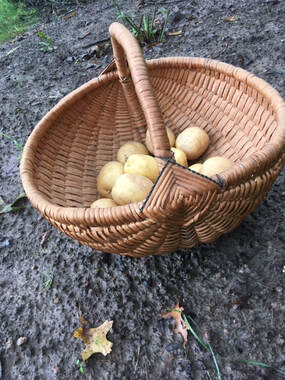 My potato basket bought in Kraków in 1980. It must have been the blood of my forefathers calling out to me or maybe it's because I love a potato in any way, shape or form but I couldn’t resist buying it. I walked through the museums and shops of that sophisticated city carrying the large potato basket until we got back to the bus. It garnered a few looks of amazement from people but I was very gratified when I was stopped on the street by a few elderly Polish women who admired my purchase and wanted to look it over, telling me it was “silny” (strong) and “dobrze zbudowany” (well built). The handle is reinforced with wire to withstand the heaviness of the potatoes. I brought it home on my lap on the plane. I have it hanging in my kitchen and is queen among the various baskets I’ve purchased over the decades. It's time to make potato soup! Photographs from Narodowe Archiwum Cyfrowe except for photo of root cellars taken from Polish Country Kitchen Cookbook.
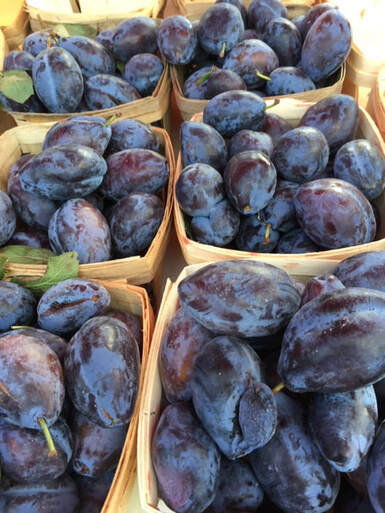 Every year, come the fall season, my mother would make great batches of thick plum jam that she called powidło for sandwiches and for making her special spiral sweet bread with jam at Christmas and Easter. Her plum of choice for making the jam was węgierki, that is, Hungarian plums (Prunus domestica-photo). This variety of plum, known in Poland for over 700 years, is believed to have come to Poland from Hungary (Węgry)via Asia Minor. According to Polish etymologists, the word “powidło,” meaning jam, appearing in the Polish language at the end of the 15th century, comes from the tool used to stir the fruit mass during the slow cooking. Another name for the “Hungarian” plum is śliwka domowa or home plum. Many a Polish manor house had its own orchard, including the plum tree whose fruit could be eaten raw, baked, fried or stewed and gained wide use in the kitchen in making compote, sweet breads, dumplings called knedle, preserves and liqueurs and, of course, plum jam. Here is an excerpt from the diary of Marianna Malinowska Jasiecka at a time when Poland was partitioned by Prussia, Russia and Austria and Poland as a country ceased to exist on the maps of Europe. Marianna was considered gentry, married to a man of considerable property, had servants and enough free time to keep a diary. She lived in a manor house in Polwica in Wielkopolska(Greater Poland) that was under Prussian rule at the time of her writing. Polwica, September 1892 “Plum jam is cooked in large white enamel kettles, not in the kitchen but out in the open air, in the orchard. The three-legged trivets I have from Pakosław(where she used to live) and I can still use them. The caretaker will be responsible for the fire beneath the kettles and the jam will cook under a slow fire. One of the kettles can hold up to 60 pounds of plums with the pits having been removed earlier. Cooking the plums takes three days and is fairly tiring work. But this year I have the cook, the parlor maids…three women over three kettles have to continuously stir the fruit with large wooden paddles being careful not to let the plums burn over the fire. I don’t use any sugar at all in the jam. When the jam is ready, it is poured into crocks, placed in a bread oven to bake in order for it to completely dry, then covered with parchment paper and placed in a cool dry pantry. Well-cooked plum jam keeps its splendid flavor until the next year.” From the book titled Marianna i Róże (Marianna and Roses). 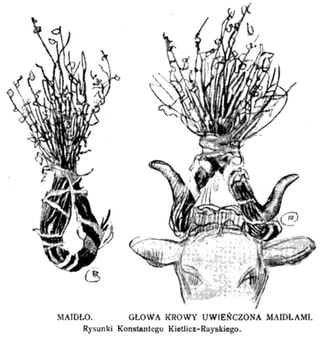 Pentecost is the Christian festival celebrating the descent of the Holy Spirit on the disciples of Jesus. It occurs in May or early June since it is, like Easter, a mobile holy day on the church calendar. The official church name in Polish is Zesłania Ducha Swiętego, the Descent of the Holy Ghost. There were many aspects to the celebration of Pentecost in Poland's agricultural past that date to ancient pre-Christian times and the pagan cult of trees, water and fire. . The illustration above from 1901 is called a maidło (most likely from the Polish word majenia, that is, to decorate with greenery) that was made by weaving together small, newly budding birch branches around the horns of the cows and tying it together at the top. The newly budded branches, symbolized the revival of life, fertility and the promise of a harvest. It was believed that the green branches also protected from spells, plagues and all evil and accounts for their widespread use in the festivities that centered around the home, barnyard, and fences. The branches of the birch tree also had the power to protect against witchcraft and the evil eye. Shepherds, wanting to include animals in the holiday (and thereby protecting them as well) decorated their cows as part of the celebration. 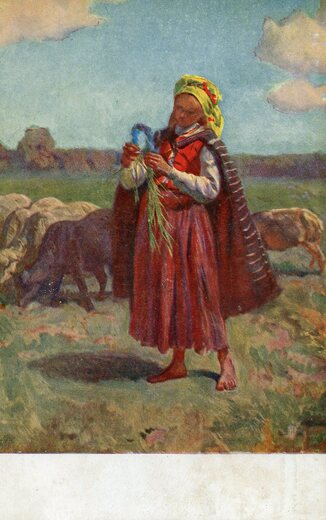 Depicting this particular custom of making a wreath for the heads of her flock is the painting by Polish artist Józef Chełmonski (1849-1914) and titled Pasterka (Shepherdess). 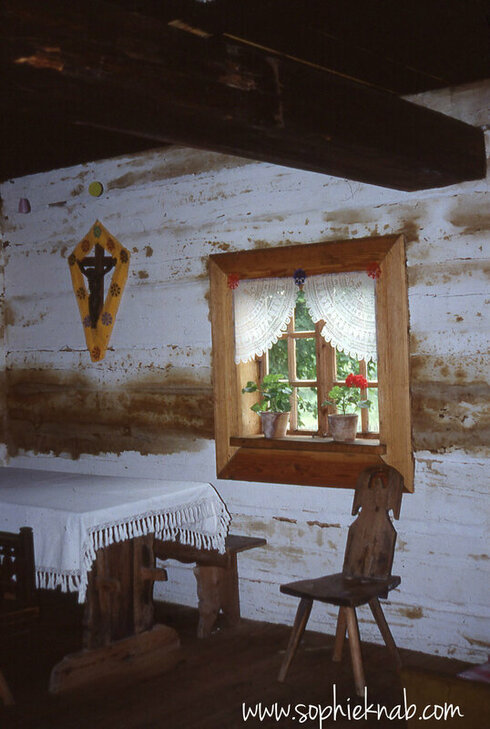 In the early years, a Polish country cottage could not boast of having a such a luxury as a window. This was something available to castles and palaces already in the 14th century in Poland but humble cottages had to wait until the 18th century, before glass and a window became the "eye" of the house to the street. The window was mostly located at the front of the house, on the gable end, facing the street and the earliest form of window decorations were the decorative exterior shutters on either side of the window. They were either carved in some interesting manner or painted. The next major form of decorating the windows in the peasant's cottage were clay pots blooming with flowers, predominantly, geraniums. I haven't been able to locate a documented source of what one particular event led to the making of lacey, white tissue paper valances that became the norm for most humble Polish cottage windows. Perhaps it was the sight of true Venetian lace by a servant that gave such servant the inspiration to copy it on something cheap and available such as white tissue paper. Some Polish folk art historians indicate that the paper curtains were another form of wycinanki, the folk art of cutting on paper. It is documented, however, by Polish folk historian Jan Dekowski, that tissue paper valances appeared in the village of Jasień, near Rawa Mazowiecki around 1910 and lasted right up until 1958. The rectangular valances were made from white tissue paper with the use of sheep shears to cut notches and circles to create a lacy effect. In this region the valance was made of two or three parts, depending on the available paper. Each part was made separately and then joined together using glue or thread. In other areas, such as Kurpie and Łowicz regions, the tissue paper was folded accordion style to fit the width of the window and then cut to achieve the desired effect. The curtains were hung on a string, a painted strip of thin wood or a rough rod whittled from a tree branch. There were also curtains just for the upper corners made from tissue paper folded into triangles. This look was something like two open fans in the top corners of the window. In the Podlasie region, rectangular paper cutout curtains also became popular after the first World War. They decorated not only windows, but also shelves on sideboards and the frames of holy paintings.(see March 2019 blog)) In addition to sheep shears, knives were used to make them. Skillful hands could cut them into complex plant-geometric or animal shapes. Another technique was to use a chisel with different blade shapes. Paper curtains were eventually replaced by curtains made of thread. The first curtains made of thread were made from flax, spun into a linen thread. These resembled something close to fishing nets. The even-spaced woven net was then stretched onto a frame of some kind and a design such as roses or branches with leaves were filled in using a single needle. You can see this interesting technique here These types of curtains made of thread became widespread in the Polish countryside in the 1930s and were popular primarily in Greater Poland, Mazowsze and Silesia, where to this day stories still circulate about the time-consuming starching and stretching of curtains made of linen thread. A special frame with dozens of nails nailed to wooden slats served for their stretching. Thanks to this treatment, the fabric, which would shrink and change shape during washing, was returned to its original form. ( I so remember my mother using these curtain stretchers when I was growing up here in the United States. Each spring, in preparation for Easter, my mother would take down the heavy winter drapes and replace them with white lace, cotton curtains, heavily starched and stretched out on the stretchers. They took up the whole front room). These type of thread curtains disappeared when nylon was discovered and began to be used to make curtains which became readily available in local shops. Everything changes but we can still admire the lengths our ancestors (and our mothers and grandmothers) went to beautify their homes with the means available at the time. When I travel through Poland, especially the small towns and villages, I don't see paper curtains in the windows except for the cottages in the skansens, the restored villages that depict life in previous centuries. What I do notice is that house after house, today's Polish housewives still prefer to hang white, lacey curtains in their windows. Photos by Sophie Hodorowicz Knab Bibliography Dekowski, Jan. Wnętrze Chaty Jasieńskie.j Pracy i Materialy Muzeum Archeologicznego i Etnograficznego #2 1958 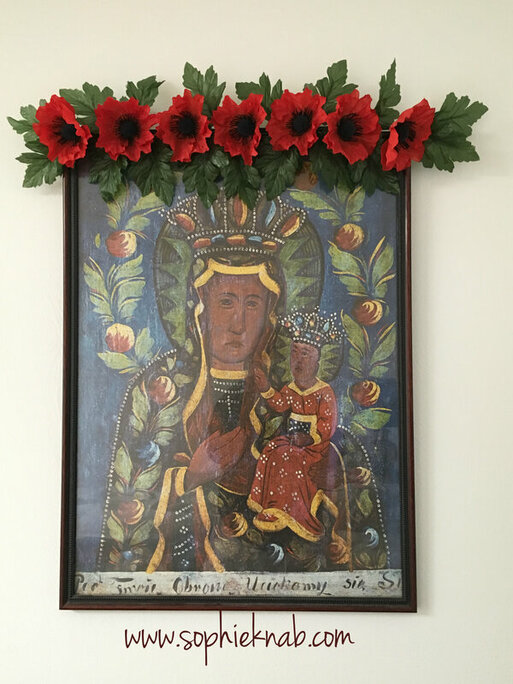 It's interesting to read how spring cleaning, now pretty much considered an antiquated ritual, was at one time an important aspect of life in Poland as part of the preparation for Easter. The impending arrival of spring and Easter Sunday, both rich with the meaning of rebirth and renewal, also meant that it was time to refresh and renew the interior of their cottages. The walls, darkened with soot and smoke from wood fires and kerosene lamps, were whitewashed, windows were cleaned and holy pictures redecorated, the latter chiefly done by the women of the house. Pictures on walls, specifically, holy pictures, in a Polish country cottage became more commonplace towards the end of the 19th century. By the time of World War I, a country cottage could boast a least a few holy pictures and many more than that, depending on finances. They were bought on pilgrimage or church feast days or from itinerant peddlers who made the rounds of villages. The pictures were hung near the ceiling in a row on the wall opposite the entryway. 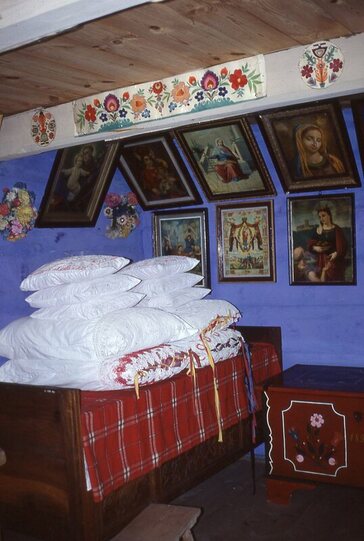 They were secured to the wall with the help of a piece of wood that ran along the length wall at ceiling level that would cause the top of the picture to tilt forward into the room. If that wall ran out of room to accommodate all the pictures, the remainder were hung on the nearby wall with a window. By the late 1930's, there was an increased tendency to place the holy pictures not so much in a row but in a more radom fashion. If, for instance, a family owned two large pictures, one was hung above the headboard of the bed(usually located in a corner against the wall) with the other one on the next wall at the same height. Smaller holy pictures were placed at the sides of both pictures..(Sierpc photo) 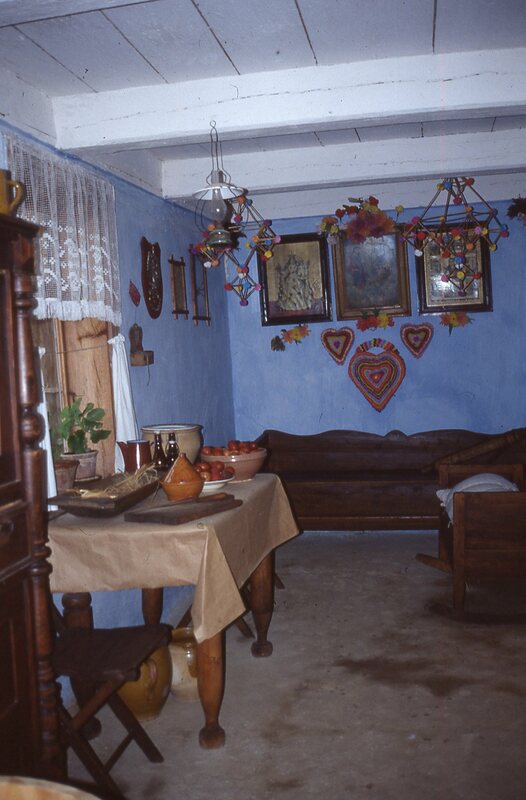 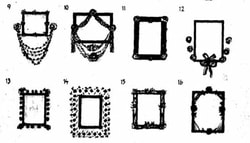 Some images were decorated with chains made from a combination of crepe paper and straw or ribbons and used as garlands below the picture, attached three quarters or halfway down the frame and fastened to the side of the frame with flowers or to the wall. For the people living at the juncture of the Wisła and San rivers, known as Lasowiacy, the larger and most cherished religious pictures during high holy days were decorated in a variety of ways. Interestingly enough, in this region spruce and fir branches were used chiefly for Easter and less so during the Christmas season. The branches were tucked behind the holy pictures, nailed around them or between them. The holy pictures were also decorated with artificial flowers, and not just in this small region of Poland, but throughout all of southern Poland. Folk art historians claim that artificial flowers made an appearance in country cottages right around the same time as wycinanki, colorful paper cut outs, due to the arrival of glossy colored paper in the 1850's. The flowers were made from a combination of stiff paper as well as crepe paper, a commodity readily available by the 18th and 19th century. The flowers themselves were made from the softer, more malleable crepe paper, and attached to thin branches covered with green crepe paper. The stiff paper was used to made into green leaves. The most frequent types of flowers made by the Lasowiacy were roses, chrysanthemums and the tiny, daisy-like flowers of chamomile. Other regions made poppies, daisies, bluebottle, forget-me-nots and cornflower (bachelor's button). The flowers were then attached to the frames in a variety of ways, either around or under the pictures. Some images were decorated with chains made from a combination of crepe paper and straw or ribbons and used as garlands below the picture, attached three quarters or halfway down the frame and fastened to the side of the frame with flowers or to the wall. The following photos depict the variety of ways the Lasowiacy decorated their holy pictures.  . As can be seen by the illustration to the left curtains made from tissue paper in white, rose, yellow or light blue colors were made to decorate the holy pictures. The paper curtain was glued to the top and half way along the length of the picture a thin ribbon was used to pull back the paper curtain as one would on a window curtain and paper flowers added. In remote villages, colorful paper and tissue flowers were used by the women folk of Poland for a long time to beautify their home at Easter. When artificial flowers, both silk and plastic, readily became available in the marketplace, they began to replace the labor intensive method of making their own. The age-old art form was almost lost but if You Tube is any indication, it seems to be making a revival in Poland. I've always loved red poppies as a flower and used silk ones to decorate my image of Our Lady of Częstochowa found at the top of the blog . Photos by Sophie Hodorowicz Knab at skansens in Łowicz and Sierpc in Poland. Next blog: Decorating Interior of Polish County Cottage Part 2 Paper curtains Bibliography: Aleksander Jackowski, Polska Sztuka Ludowa. Warsawa 2002. Zdobnictwo Wnętrz Wiejskich na Terenie Wideł Wisły i Dolnego Sanu. Polska Sztuka Ludowa. 1973 XXVII nr.3 (illustrations) 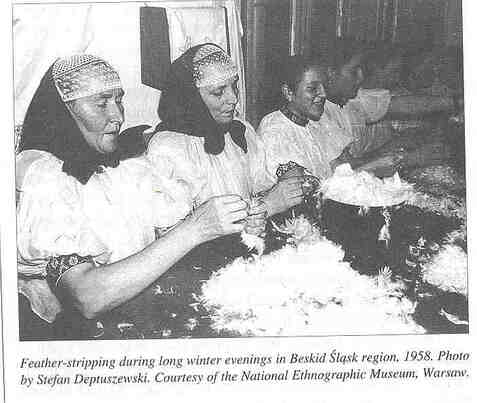 This is another entry from the month of February from the diary of Marianna Malinowska Jasiecka in the years 1890-1914 compiled by Janina Fedorowicz and Joanna Konopinska. It describes the custom of women getting together during the long, cold (and often tedious) winter nights to strip feathers. The women got together at each other's homes to help each other strip the down off the quill of feathers obtained from ducks, geese and chickens in order to make pillows and comforters. Done alone, it was an onerous task. Done together it was a social event lightened with talk, music and food. These get-togethers lasted only until the beginning of Lent when all such social activities ended. Polwica, February 1895 Besides the domestic help, a few women and girls from the manor farm and from the village have come to strip feathers. Sometimes there's twenty people who gather together. The feathers from ducks and geese and the better feathers from chickens are stored in white bags in the attic. We've brought them down to the room designated for stripping and so as not to mix the different types of feathers, the contents of each bag is placed on separate tables. The best down is obtained from geese and these are later made into pillows. The kołdry and pierzyny (feather quilts) are made from mixed down. The feathers that aren't stripped that is, the worst ones mixed with chicken feathers are cut with scissors instead and made into spodków----or as some call it, a feather bed, which is placed on the mattress to make it soft and warm. Recently I've been hearing some talk that sleeping on feather beds is not healthy. Even my girls refused to sleep on the feather bed the last time they were home during winter recess saying that nobody slept on them at school. I can see I'm old fashioned since I sleep on a feather bed from November to April. Michael does the same. Stripping feathers generally starts in country cottages right after the feast of Three Kings and lasts until the middle of February. Here it will probably last till the end of the month. After supper, around 7pm the women start arriving and take seats on long benches and work until 9 or 10 in the evening while at the same time sharing news, gossip from the entire neighborhood and even legends. One of the favored themes are tales about unusual happenings, about spirits. It happens at times that some of the local young men stop by to see the girls and play on the harmonic or fiddle, everyone sings and its very merry...these evenings have a charm all their own. Outside it is cold and snowing, a frequent storm and darkness with the wind howling beyond the windows and we sit in warmth with kerosene lamps lighting the interior and the roll of pleasant conversation. At the end of the work, Bejmowa(servant) brings out coffee made from grain with milk and large chunks of freshly baked sweet bread and offers it to everyone. Stripping feathers is a bit of a fashion show. On such a night the girls and younger women dress up to show each other their clothes, explain how to embroider a particular motif for an apron or ruffle, how to crochet a scarf or trim stockings that are knitted from wool. I always wonder when they have time to crochet and embroider. The country woman is always overburdened with work in the house and field, has a passle of children. Where does she find the time for something like hand work. But the women manage to do so and often very nicely. Mama encourages the girls to knit, believing that it is an indispensible skill in the life of even the most well to do women. So even small Jadzia knows how to make wool socks and knows some basic crochet work. 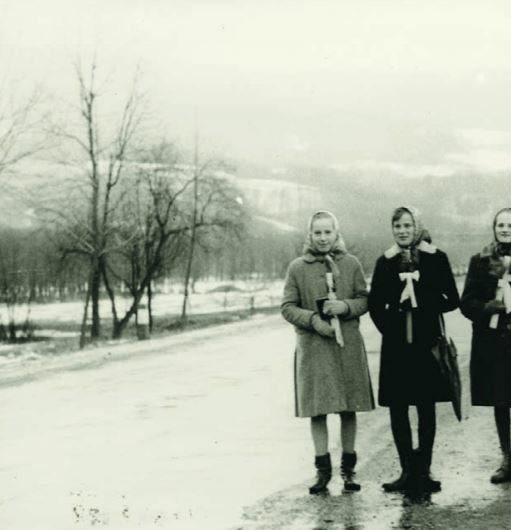 I have loved reading diaries since I was in elementary school. I still read children's diaries, teen and adult ones and I especially enjoy diaries kept by Polish women. The book "Marianna i Róże" (Marianna and Roses) was written by a female descendant of Marianna Malinowska Jasiecka. It is based on a compilation of family documents, historical facts and the contents of a diary kept by Marianna Malinowska Jasiecka that was found in an old chest. The diary begins in April of 1892 at a time when Poland was partitioned by Prussia, Russia and Austria and Poland as a country ceased to exist on the maps of Europe. Marianna was considered gentry, married to a man with a significant amount of property, had servants and enough free time to keep a diary. She lived in a manor house in Polwica in Wielkopolska(Greater Poland). Her entries are filled with her day-to-day life as wife and mother, her family history and genealogy, what life was like under Prussian rule but also includes the yearly customs and traditions of the times. Here is an excerpt for Candlemas, celebrated on February 2. Polwica, February 1895 In the morning we went to our parish church in Śniecisk. Everyone had a large blessed candle called a gromnica, decorated with a white ribbon and a sprig of myrtle (author note:myrtus communis). The "gromnica" or blessed candle is lit when expecting the priest to come "na kolęda"( author note:Christmas visit by the parish priest) or to visit the sick as well as during a storm and definitely when someone was dying or next to the already deceased individual. There still exists among the village people a superstition that if someone manages to bring their lit candle from church to their home, then no one from that family will die that year. As a result everyone tries to get home with their candle still lit. Depending on the weather, it's not always easy. It's amusing how people walking along the road are protecting the faint glimmers of light with their scarves or coat so it doesn't go out. The candles are kept near holy pictures or, as is with us, in special candleholders. The candle is lit during storms to distance away the thunder and placed in the hands of the dying so that they can have an easy death and can more easily find the gates of heaven by the light of the blessed candle. That is why the holy day is cherished and solemnly observed. My next blog will share another entry from Marianna's diary depicting the stripping of feathers for making pillows and a pierzyna (down quilt). Google photo/ Young Polish girls with their gromnica (thunder candle) Date unknown.  Unlike many countries where the names of the months are derived the ancient Roman calendar, the names of the months on the Polish calendar generally come from some aspect of nature or the yearly agricultural cycle. For instance, Kwiecien, the month of April comes from the word kwitnie (blossoming). The month of July, is named Lipiec, from lipa, the linden tree that blooms so profusely during this month and is the source of wood used for carving and much loved by the bees that produce honey. October is no exception. The Polish word for the month is Październik. The word comes from the word paździerz, the inner fiber of the all-important flax plant (Linium usitatissium). The flax plant was grown primarily by families to provide themselves with what would eventually become a piece of cloth. In olden days, whether you lived in America or in Poland, this was no small feat. If you wanted to eat, you had to produce your own food. If you wanted clothes on your back, you had to produce your own clothes and if you didn't have access to sheep for wool, you grew your own flax. The flax seeds were generally planted in April and grew throughout the summer season. When it was ready in October, the process of converting the flax plant into a usable fiber began and was generally regarded as the work of women. Step 1. The plant was was pulled out of the earth, tied into bundles and taken to the barns where it was dried very well. Then the flower heads were either combed or beaten to obtain the valuable flax seeds. Some of the seeds were saved and put aside for the next years planting. Some was crushed to obtain the all important flaxseed oil which was used specifically for frying and cooking purposes during the strict fasts of Advent and Lent when all meat and most meat products were eliminated from the diet. The leftover mash from the crushed seeds was fed to the cattle. Step 2. The stems were then subject to a long-term treatment of exposure to water to help break down the plant structure to separate the fibers of the plant. This was done by spreading the stems out on grass when it was wet with dew, called dew retting. The stems were turned regularly to make sure all sides rotted equally. Dew retting would eventually yield a final thread that was gray in color and a hallmark of many older Polish linen tablecloths, shirts and blouses. Stems soaked directly in water would produce thread that was a light blond color Step 3. The stalks were dried again. Mind you, all this is taking two to three weeks to get to the next step. Step 4. Braking. The fiber that our ancestors were looking for was located on the outer skin of the flax stem. This was obtained when the prepared flax stems were now forced to bend into the shape of a W, using a tool called a brake (in Polish, międlica). It broke the inner layer (the paździerz), which would drop off, leaving the long outer layers, the flax fiber. Step 5. Not quite the last step was the combing of the flax fibers into something smooth that could be spun called combing with the use of a hatchel. (photo) Step 6. The Polish housewife now had a product that she could actually work with and spun it into a thread using a drop spindle or a spinning wheel. She spent the winter months spinning and then weaving the linen thread into cloth. The cloth became a sheet for a bed, a pillowcase, a hand towel or, more importantly, a blouse or a shirt. Something to think about when we visit the museums in Poland displaying folk costumes of the past. Photo:Woman spinning courtesy of Polish Ethnographic Museum in Warsaw Photo Collage: Google images |
Categories
All
One of the biggest moments in my life was being able to sign for my very own library card. When I'm not reading, researching and writing I'm riding my bike, sewing or gardening. I love flea markets, folk art, and traveling to Poland.
Archives
July 2024
|
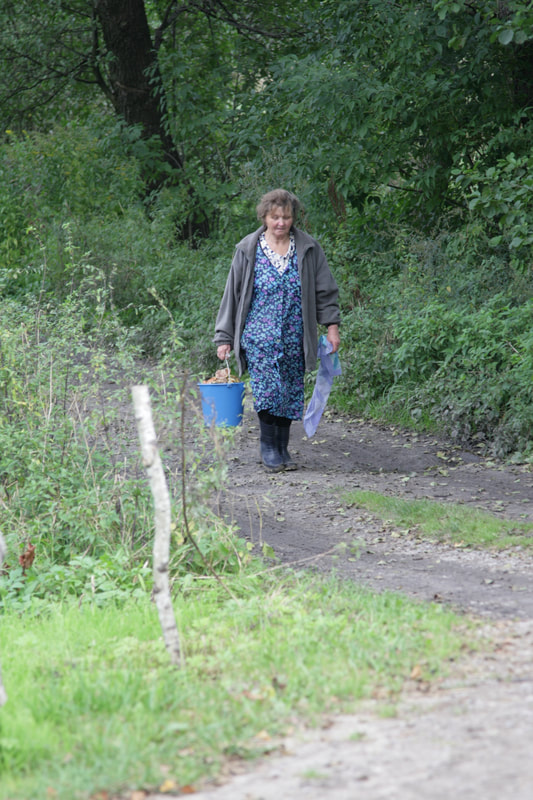
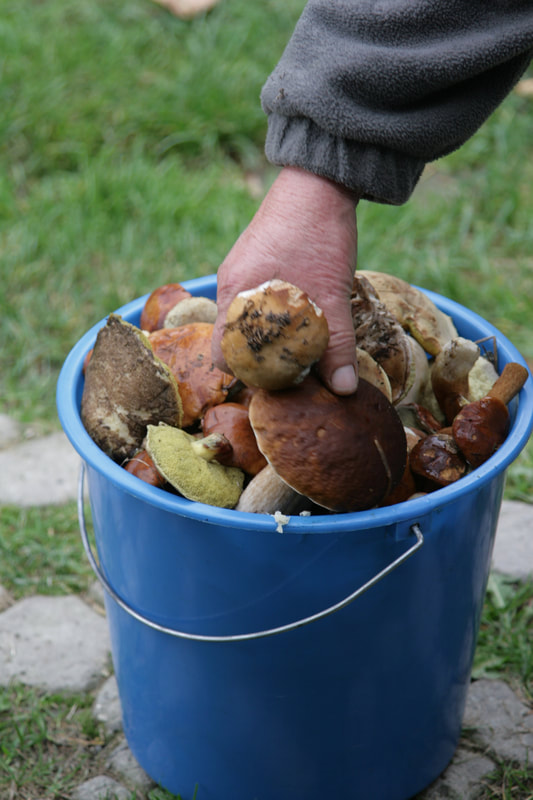
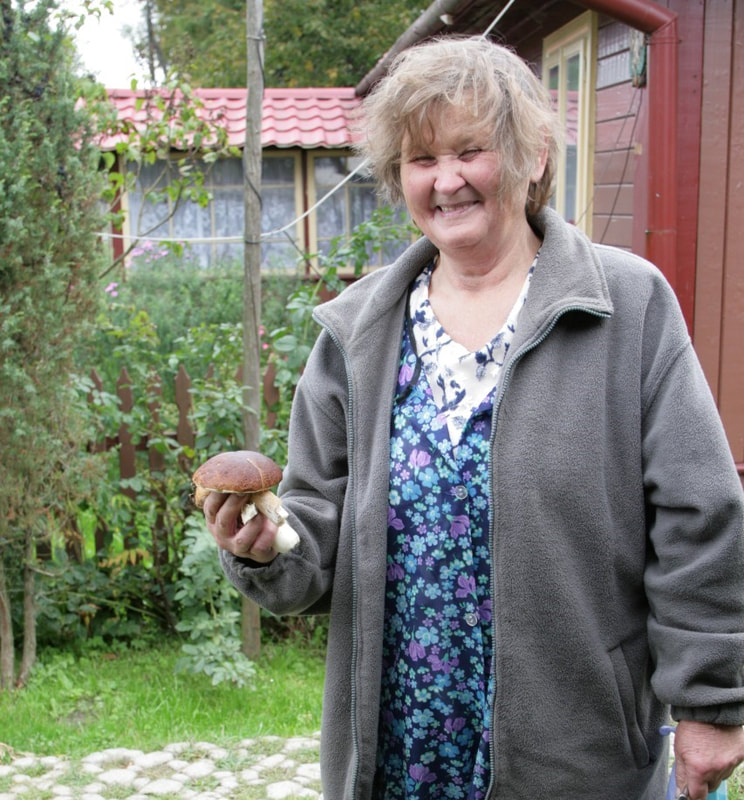
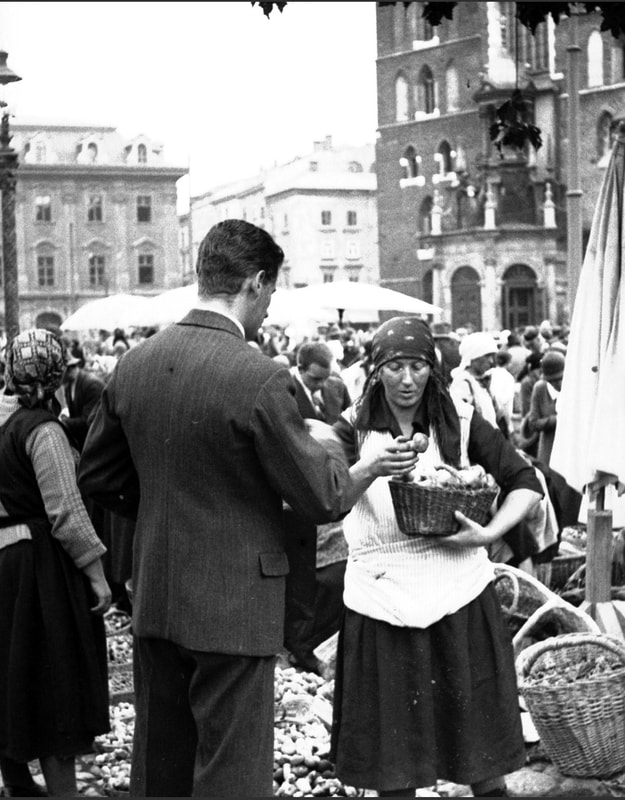
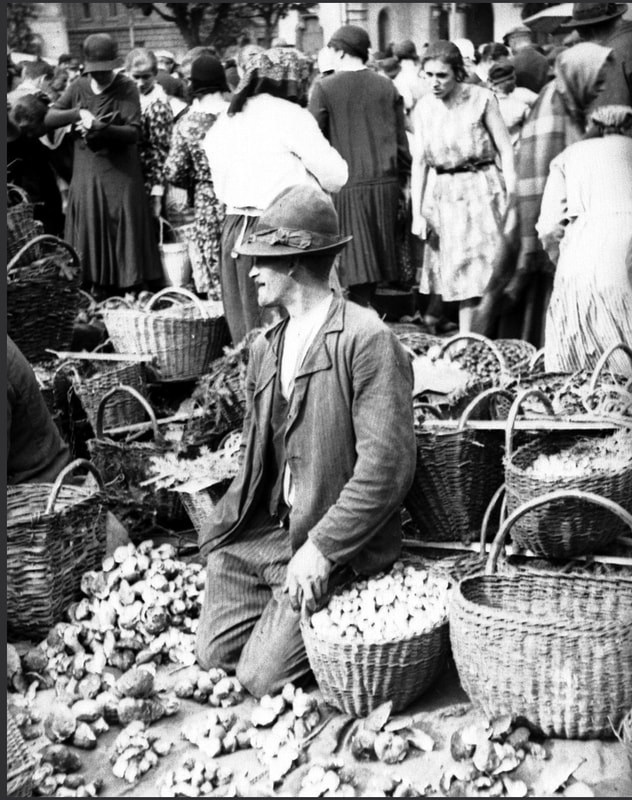
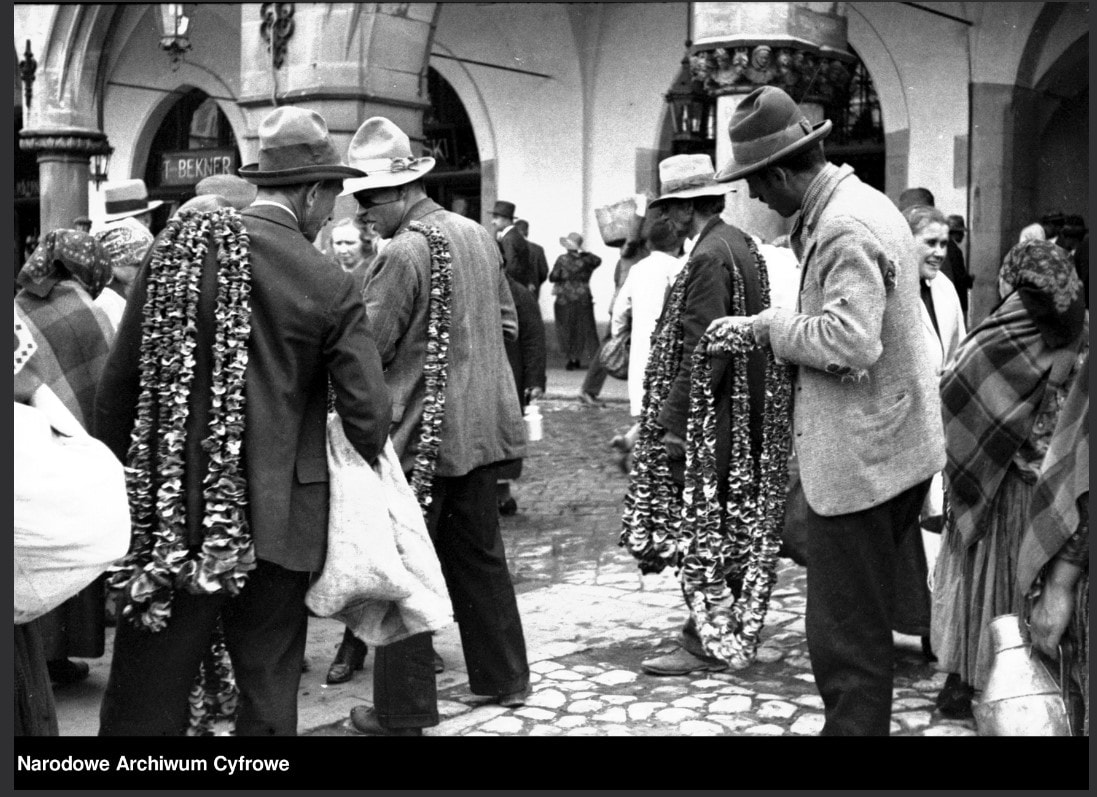
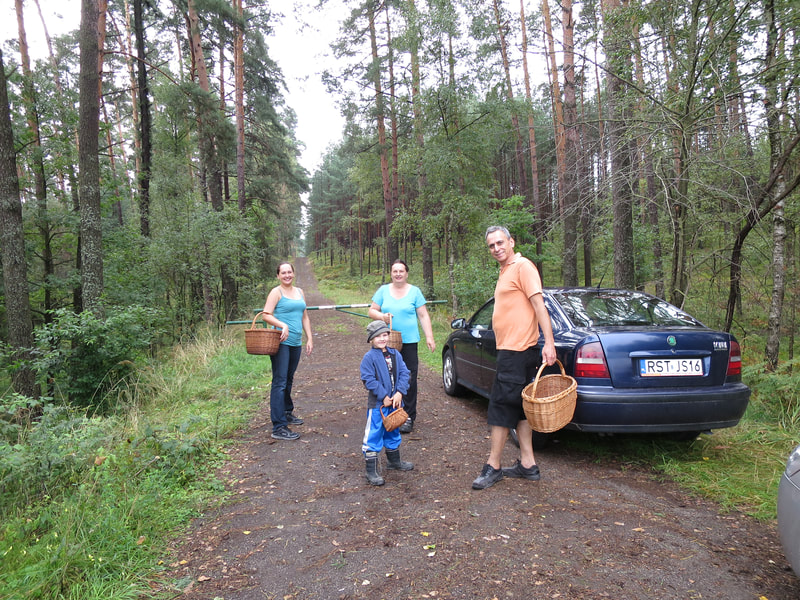
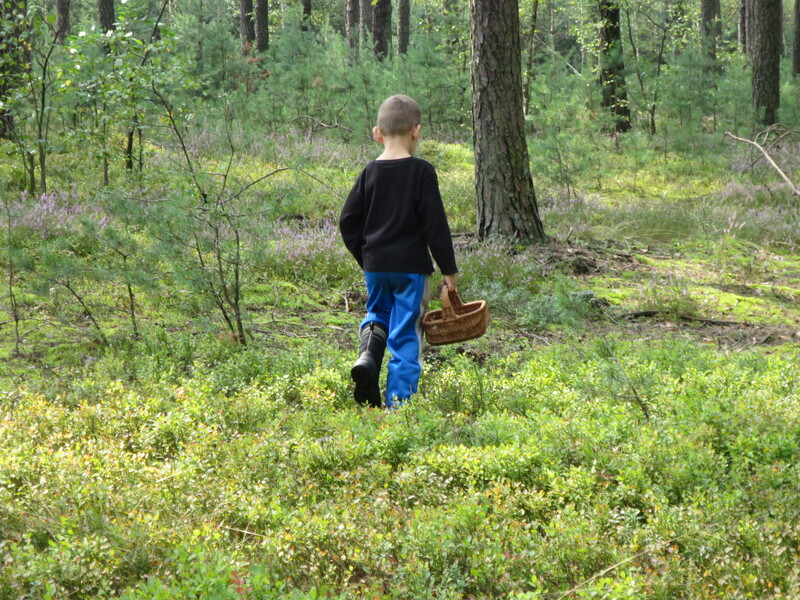
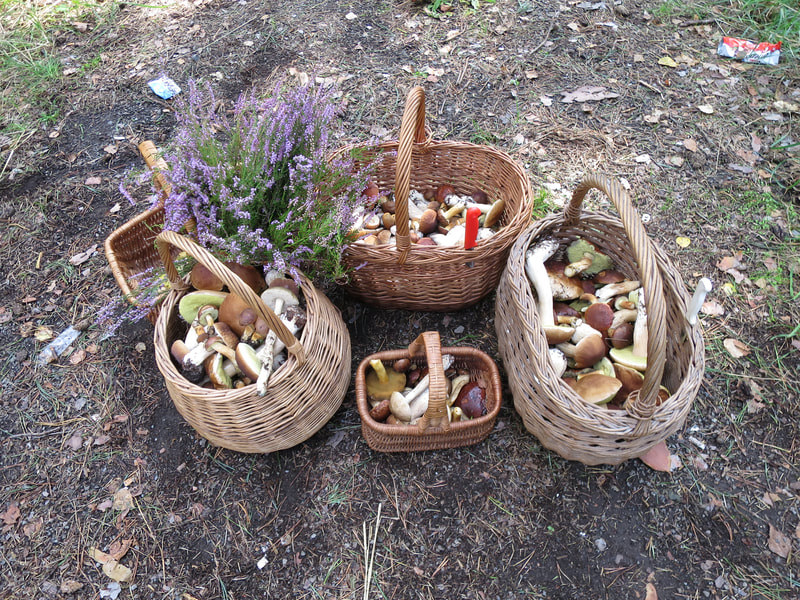
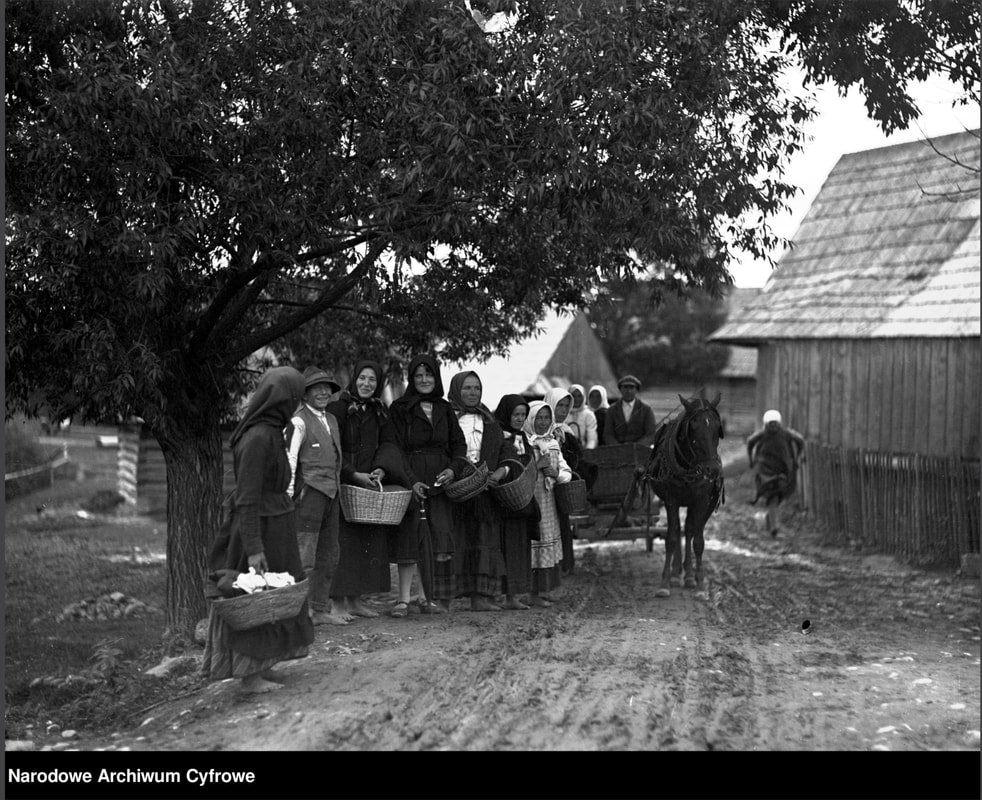
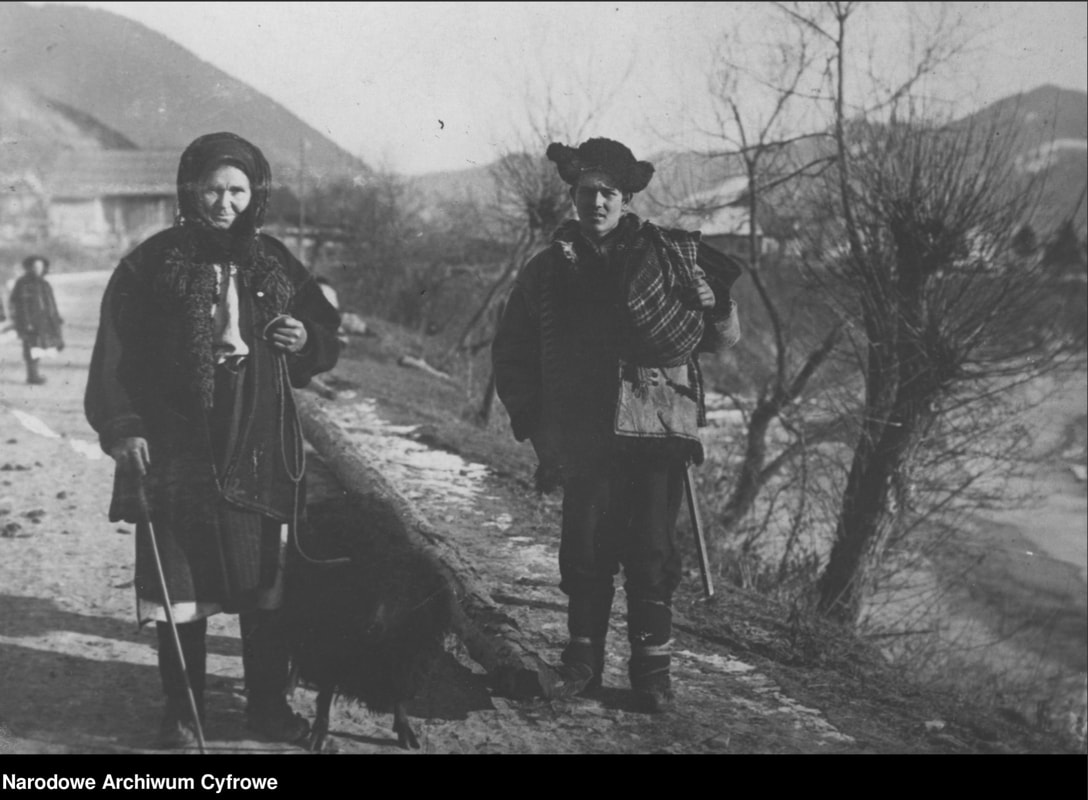
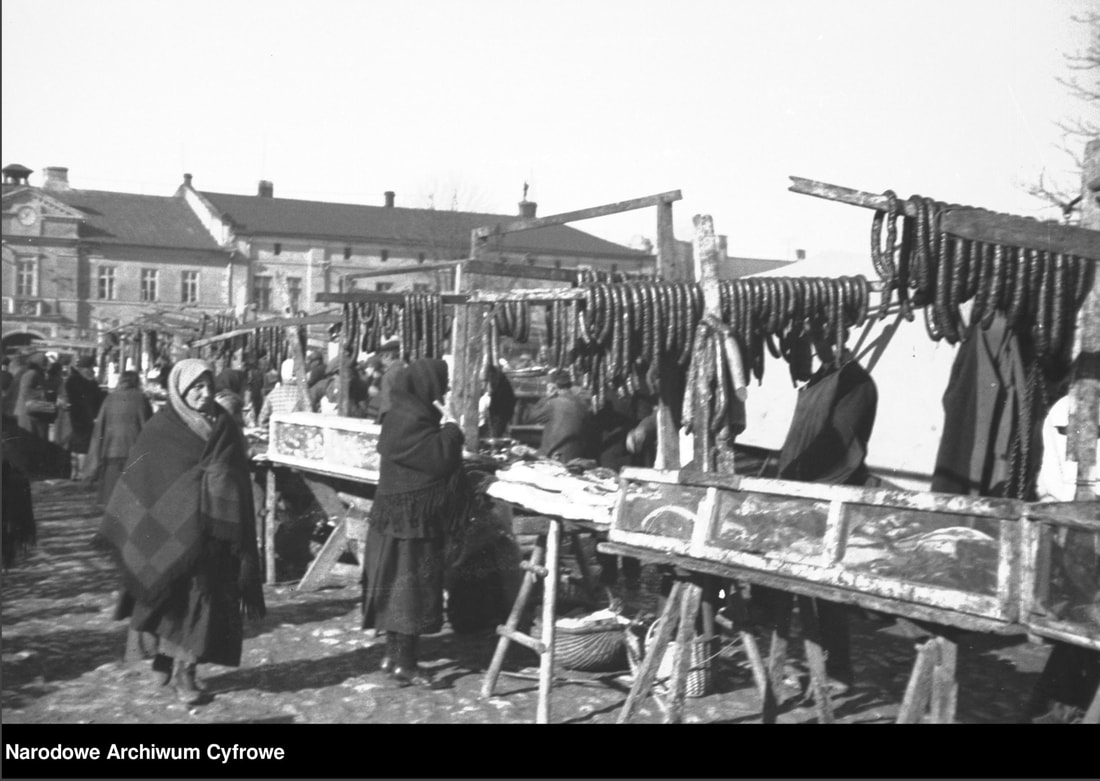
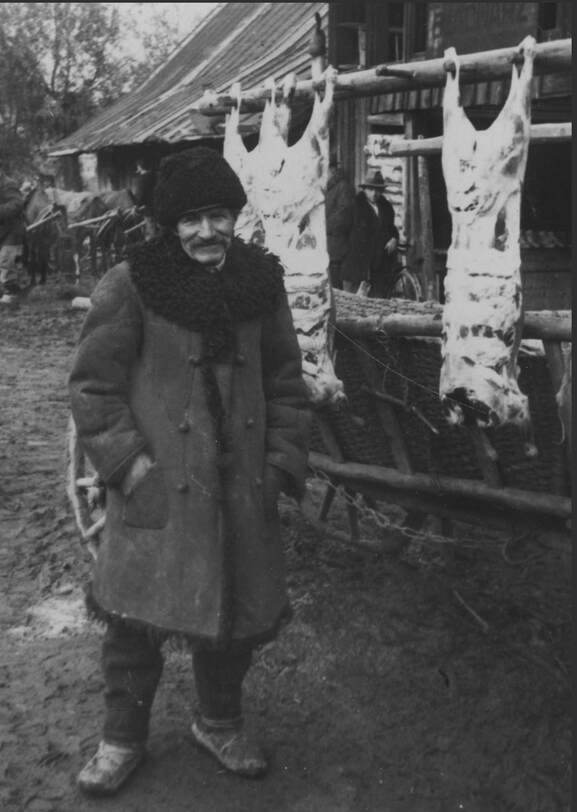
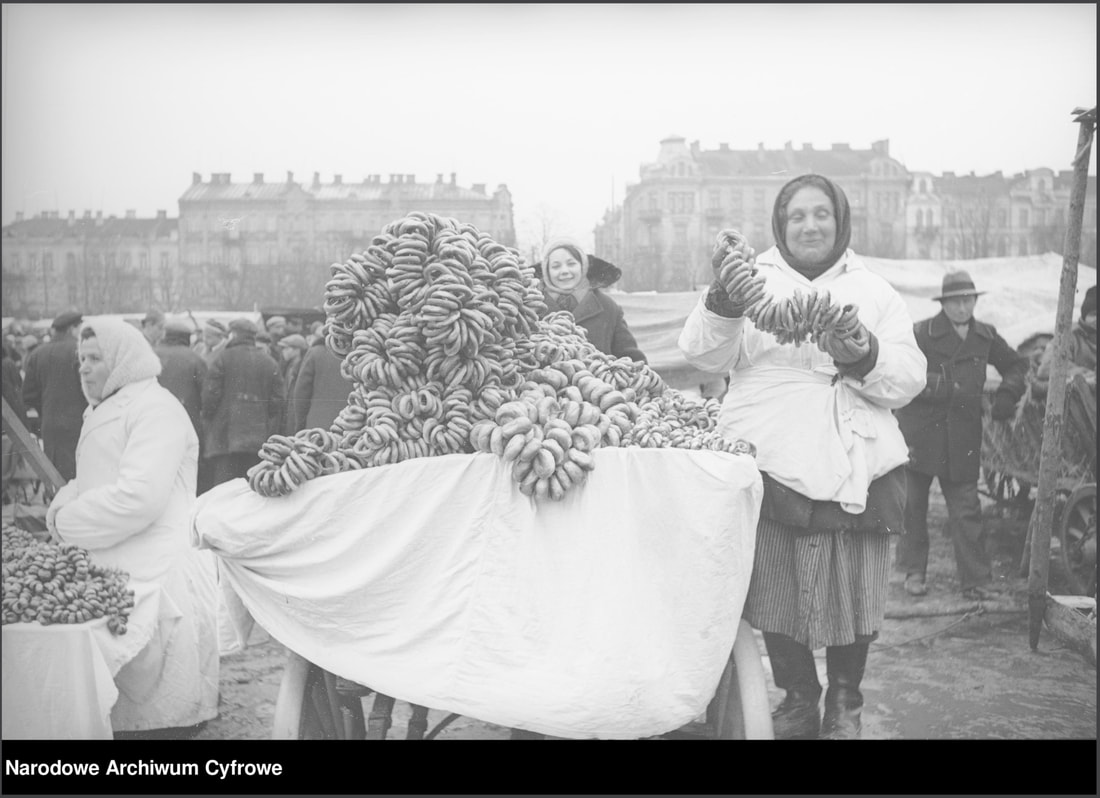
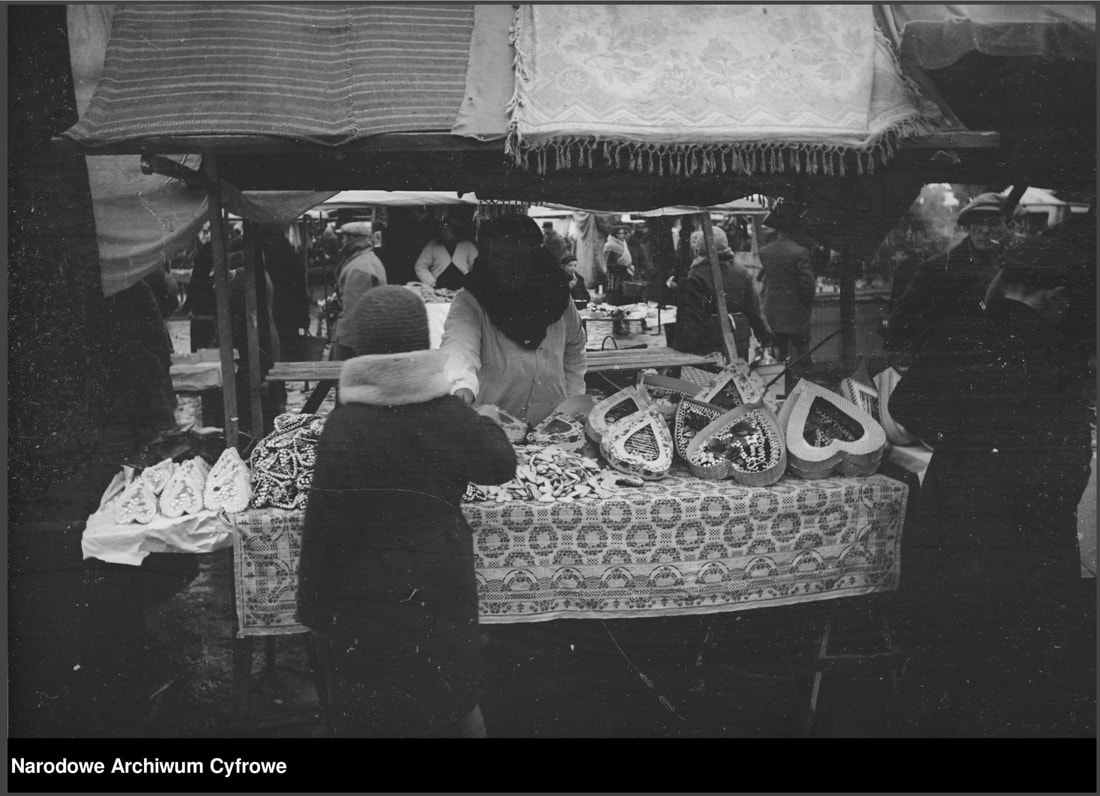
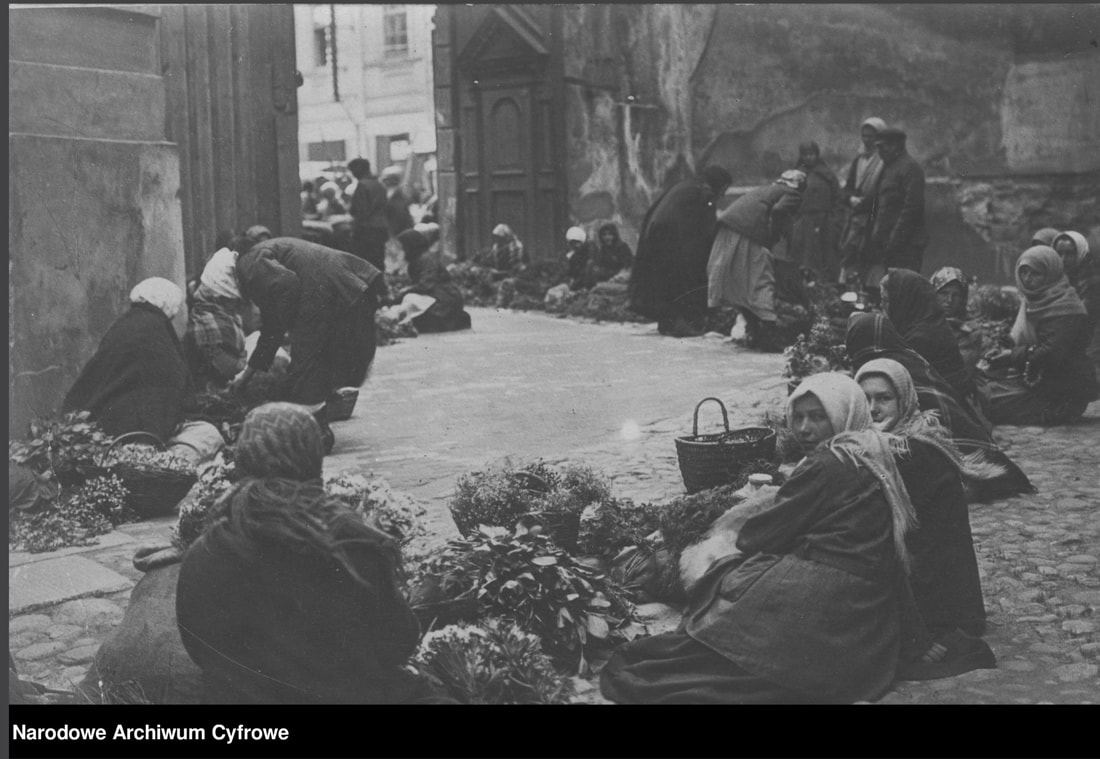
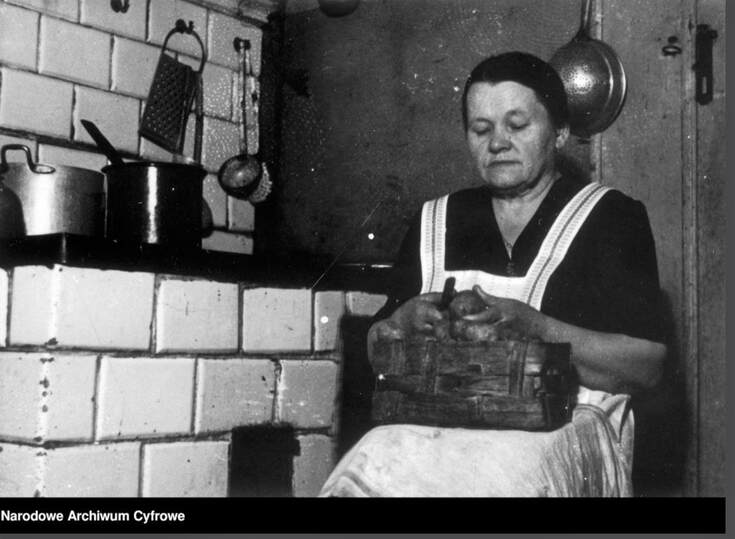
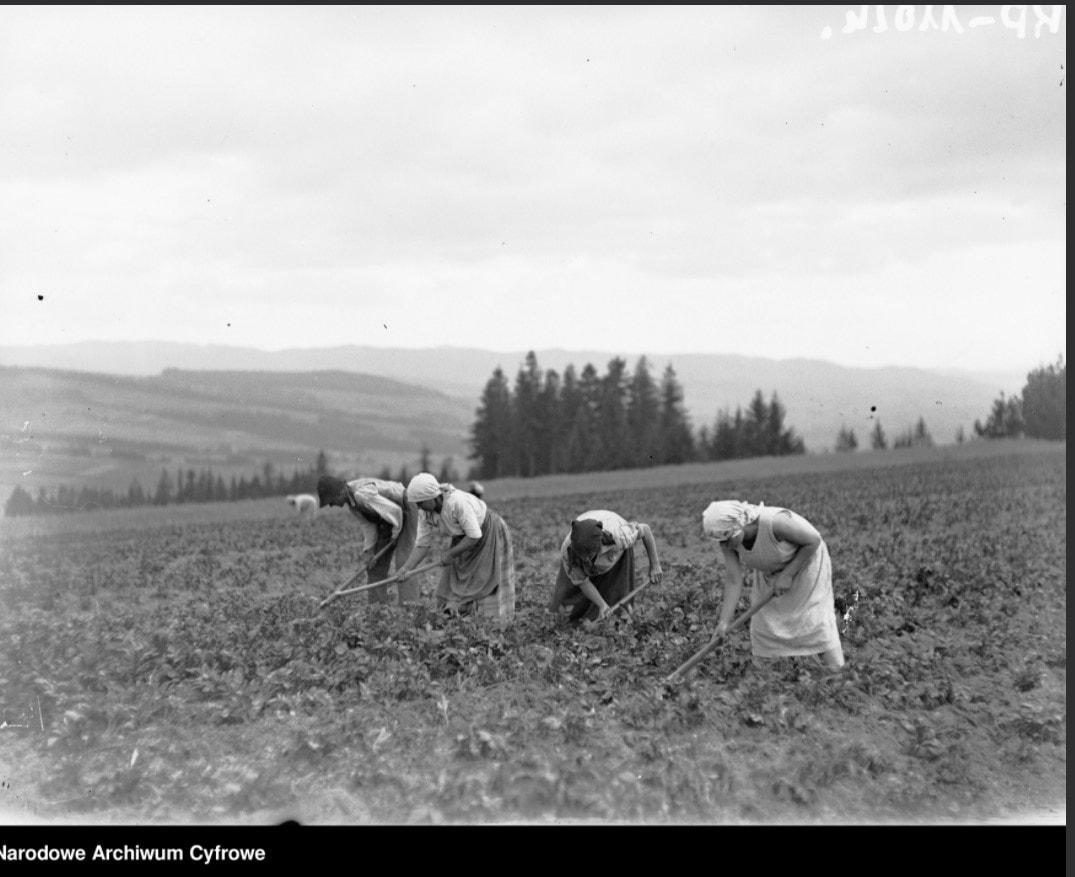
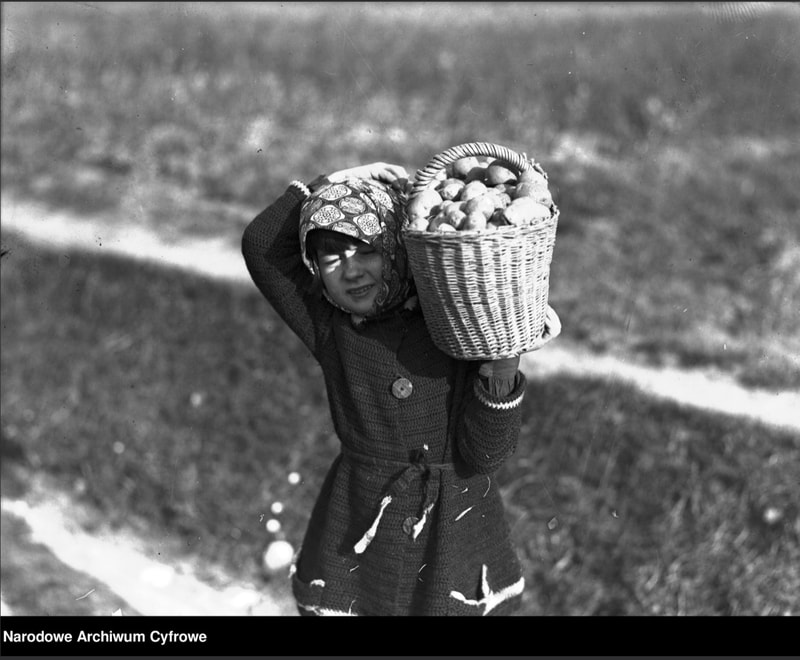
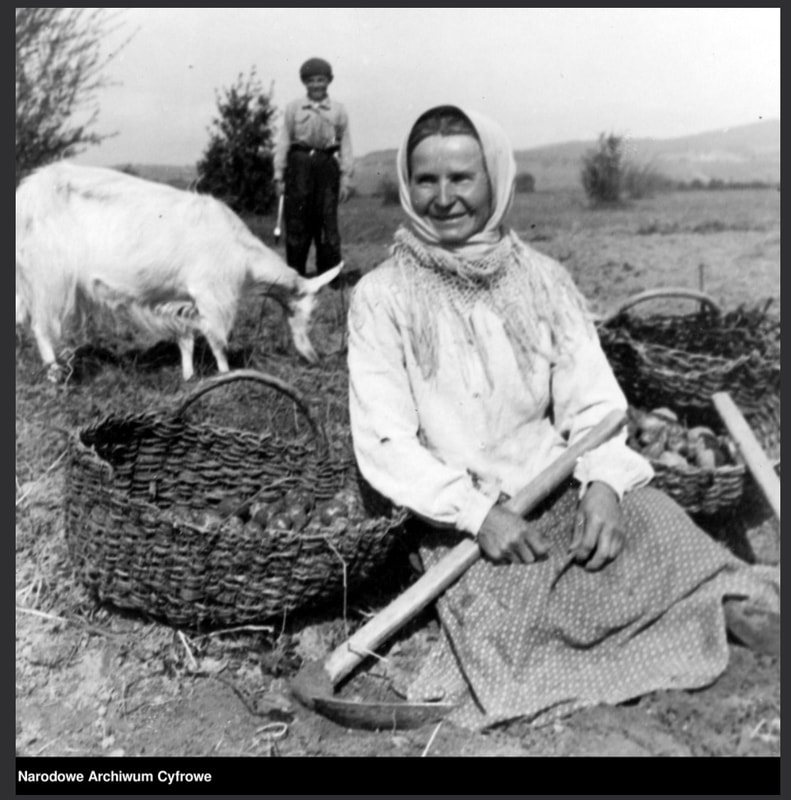
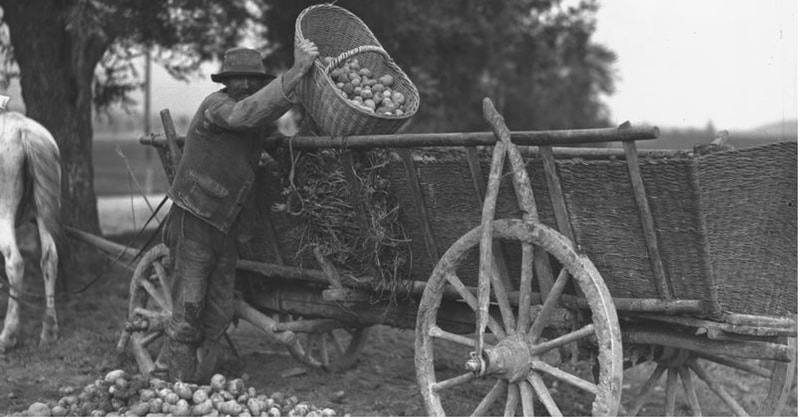
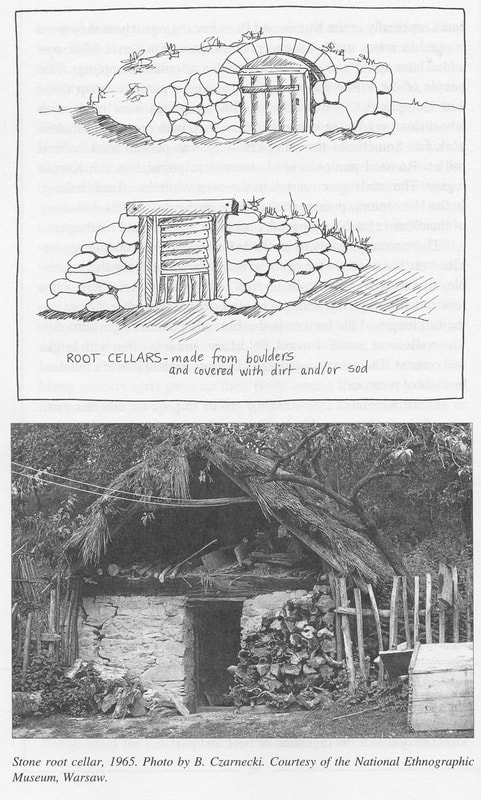
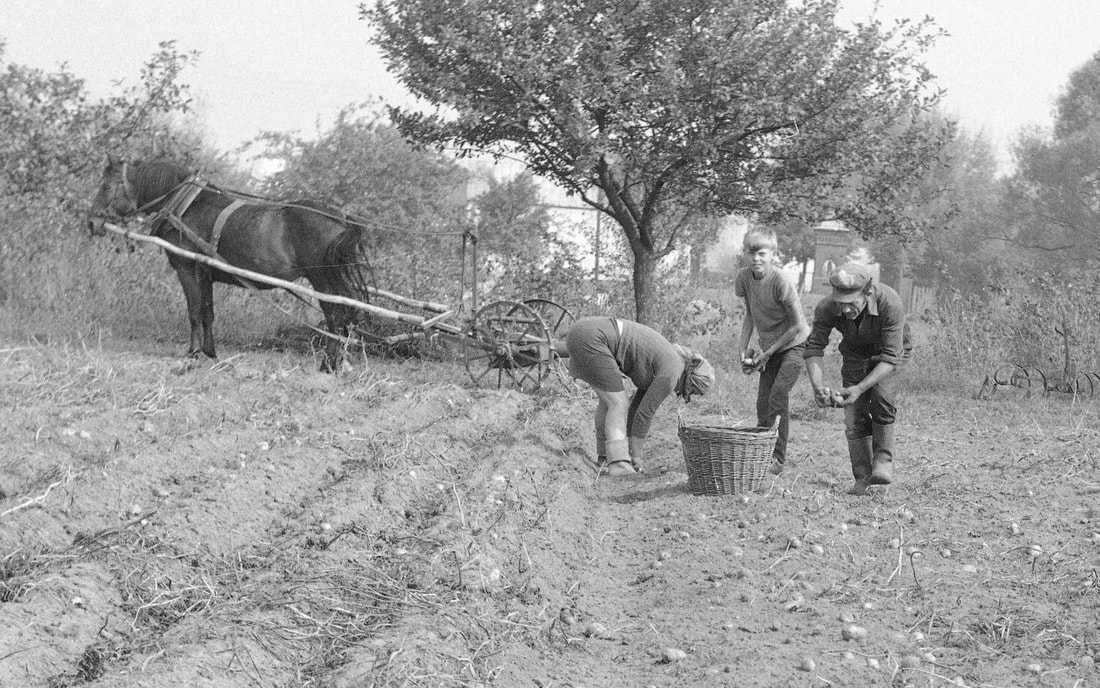
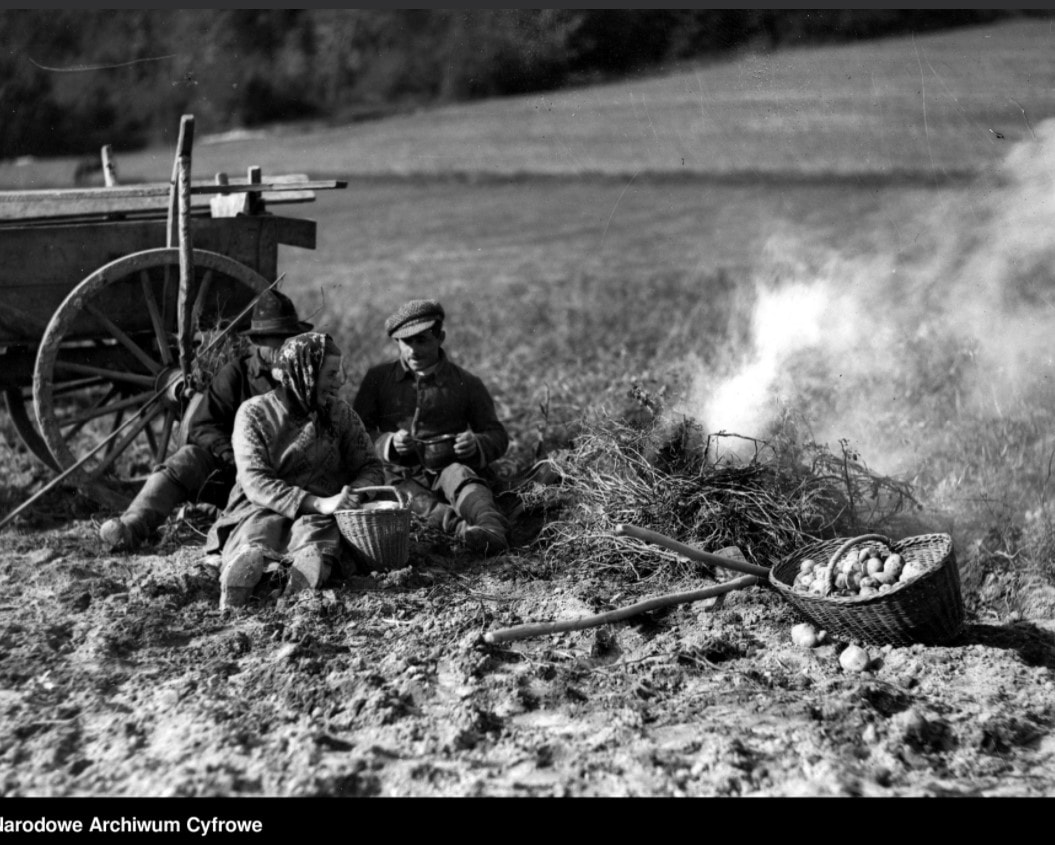
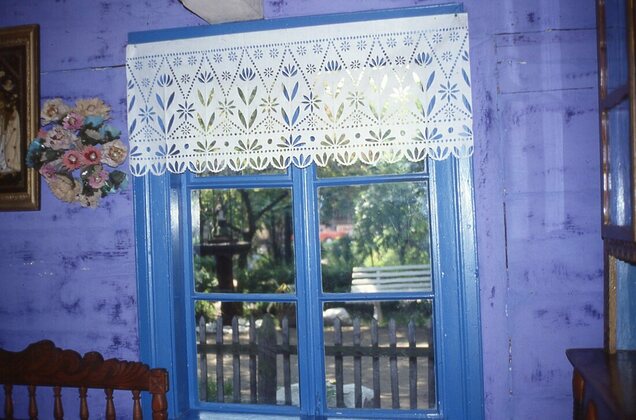
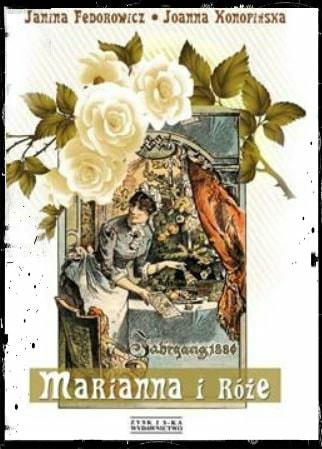
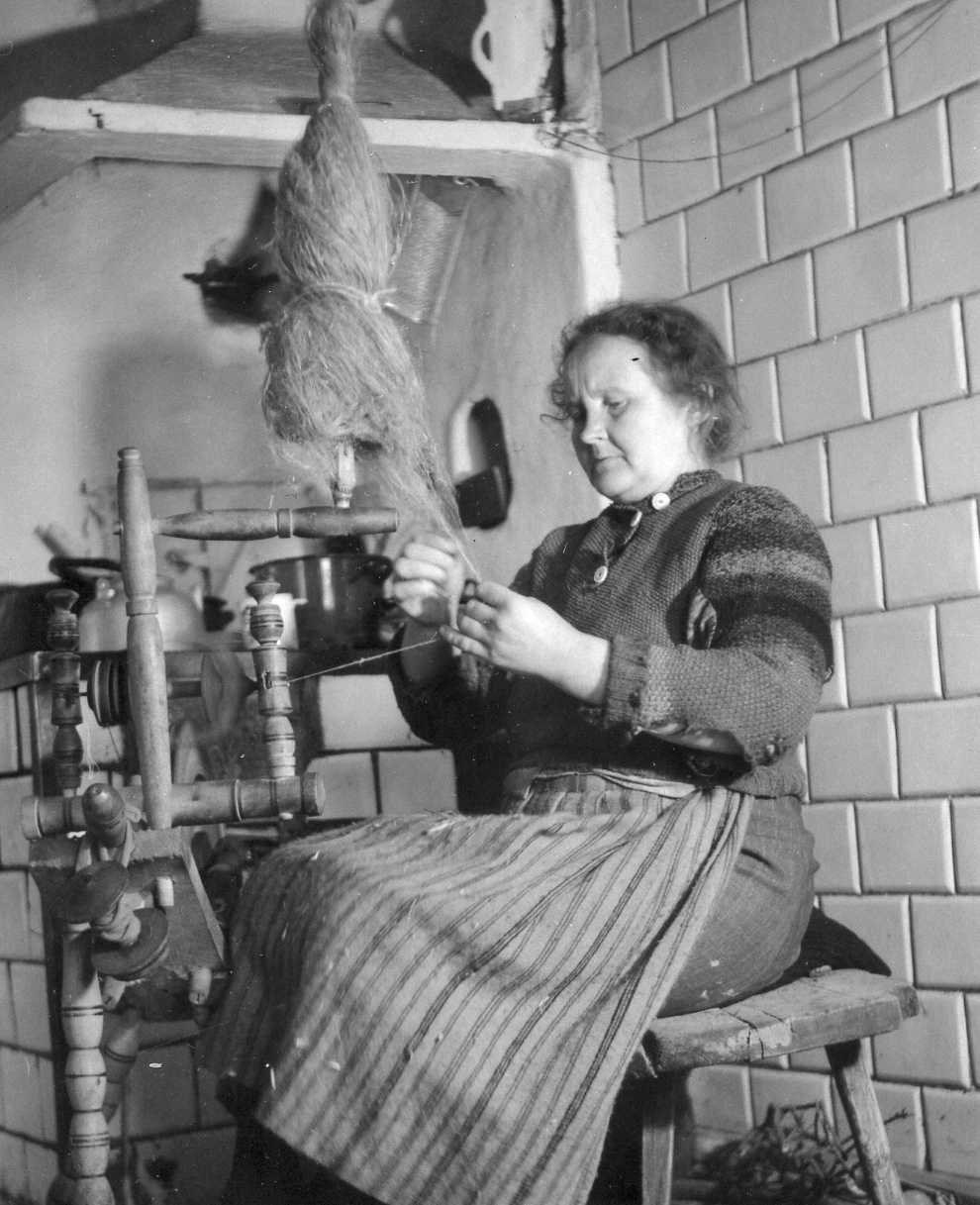
 RSS Feed
RSS Feed